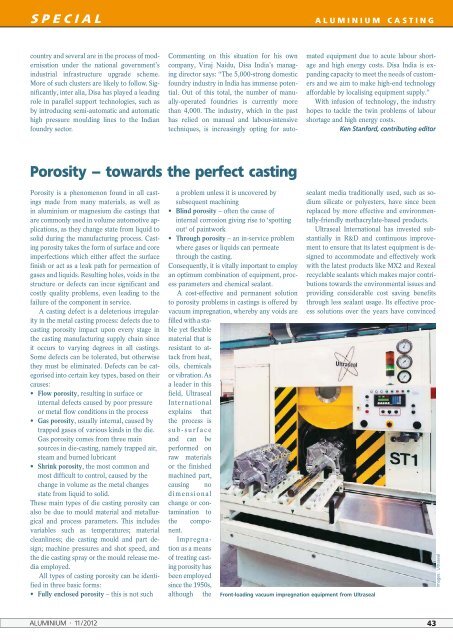special - ALUMINIUM-Nachrichten – ALU-WEB.DE
special - ALUMINIUM-Nachrichten – ALU-WEB.DE
special - ALUMINIUM-Nachrichten – ALU-WEB.DE
You also want an ePaper? Increase the reach of your titles
YUMPU automatically turns print PDFs into web optimized ePapers that Google loves.
SPECIAL<br />
<strong><strong>ALU</strong>MINIUM</strong> CASTING<br />
country and several are in the process of modernisation<br />
under the national government’s<br />
industrial infrastructure upgrade scheme.<br />
More of such clusters are likely to follow. Significantly,<br />
inter alia, Disa has played a leading<br />
role in parallel support technologies, such as<br />
by introducing semi-automatic and automatic<br />
high pressure moulding lines to the Indian<br />
foundry sector.<br />
Commenting on this situation for his own<br />
company, Viraj Naidu, Disa India’s managing<br />
director says: “The 5,000-strong domestic<br />
foundry industry in India has immense potential.<br />
Out of this total, the number of manually-operated<br />
foundries is currently more<br />
than 4,000. The industry, which in the past<br />
has relied on manual and labour-intensive<br />
techniques, is increasingly opting for automated<br />
equipment due to acute labour shortage<br />
and high energy costs. Disa India is expanding<br />
capacity to meet the needs of customers<br />
and we aim to make high-end technology<br />
affordable by localising equipment supply.”<br />
With infusion of technology, the industry<br />
hopes to tackle the twin problems of labour<br />
shortage and high energy costs.<br />
Ken Stanford, contributing editor<br />
Porosity <strong>–</strong> towards the perfect casting<br />
Porosity is a phenomenon found in all castings<br />
made from many materials, as well as<br />
in aluminium or magnesium die castings that<br />
are commonly used in volume automotive applications,<br />
as they change state from liquid to<br />
solid during the manufacturing process. Casting<br />
porosity takes the form of surface and core<br />
imperfections which either affect the surface<br />
finish or act as a leak path for permeation of<br />
gases and liquids. Resulting holes, voids in the<br />
structure or defects can incur significant and<br />
costly quality problems, even leading to the<br />
failure of the component in service.<br />
A casting defect is a deleterious irregularity<br />
in the metal casting process: defects due to<br />
casting porosity impact upon every stage in<br />
the casting manufacturing supply chain since<br />
it occurs to varying degrees in all castings.<br />
Some defects can be tolerated, but otherwise<br />
they must be eliminated. Defects can be categorised<br />
into certain key types, based on their<br />
causes:<br />
• Flow porosity, resulting in surface or<br />
internal defects caused by poor pressure<br />
or metal flow conditions in the process<br />
• Gas porosity, usually internal, caused by<br />
trapped gases of various kinds in the die.<br />
Gas porosity comes from three main<br />
sources in die-casting, namely trapped air,<br />
steam and burned lubricant<br />
• Shrink porosity, the most common and<br />
most difficult to control, caused by the<br />
change in volume as the metal changes<br />
state from liquid to solid.<br />
These main types of die casting porosity can<br />
also be due to mould material and metallurgical<br />
and process parameters. This includes<br />
variables such as temperatures; material<br />
cleanliness; die casting mould and part design;<br />
machine pressures and shot speed, and<br />
the die casting spray or the mould release media<br />
employed.<br />
All types of casting porosity can be identified<br />
in three basic forms:<br />
• Fully enclosed porosity <strong>–</strong> this is not such<br />
a problem unless it is uncovered by<br />
subsequent machining<br />
• Blind porosity <strong>–</strong> often the cause of<br />
internal corrosion giving rise to ‘spotting<br />
out‘ of paintwork<br />
• Through porosity <strong>–</strong> an in-service problem<br />
where gases or liquids can permeate<br />
through the casting.<br />
Consequently, it is vitally important to employ<br />
an optimum combination of equipment, process<br />
parameters and chemical sealant.<br />
A cost-effective and permanent solution<br />
to porosity problems in castings is offered by<br />
vacuum impregnation, whereby any voids are<br />
filled with a stable<br />
yet flexible<br />
material that is<br />
resistant to attack<br />
from heat,<br />
oils, chemicals<br />
or vibration. As<br />
a leader in this<br />
field, Ultraseal<br />
International<br />
explains that<br />
the process is<br />
sub-surface<br />
and can be<br />
performed on<br />
raw materials<br />
or the finished<br />
machined part,<br />
causing no<br />
dimensional<br />
change or contamination<br />
to<br />
the component.<br />
Impregnation<br />
as a means<br />
of treating casting<br />
porosity has<br />
been employed<br />
since the 1950s,<br />
although the<br />
sealant media traditionally used, such as sodium<br />
silicate or polyesters, have since been<br />
replaced by more effective and environmentally-friendly<br />
methacrylate-based products.<br />
Ultraseal International has invested substantially<br />
in R&D and continuous improvement<br />
to ensure that its latest equipment is designed<br />
to accommodate and effectively work<br />
with the latest products like MX2 and Rexeal<br />
recyclable sealants which makes major contributions<br />
towards the environmental issues and<br />
providing considerable cost saving benefits<br />
through less sealant usage. Its effective process<br />
solutions over the years have convinced<br />
Front-loading vacuum impregnation equipment from Ultraseal<br />
Images: Ultraseal<br />
<strong><strong>ALU</strong>MINIUM</strong> · 11/2012 43
















